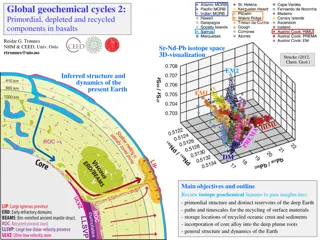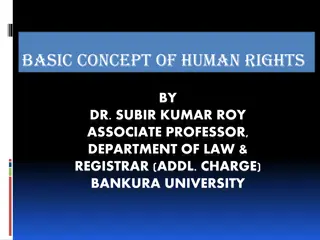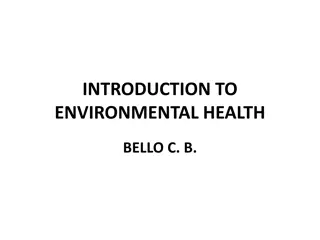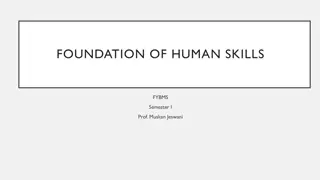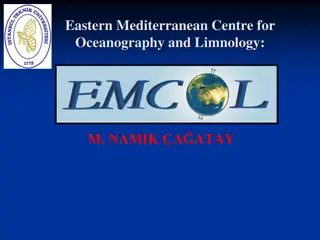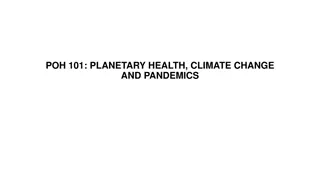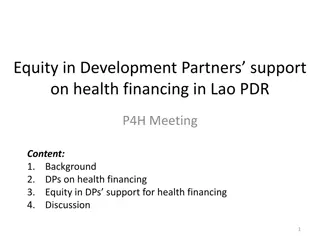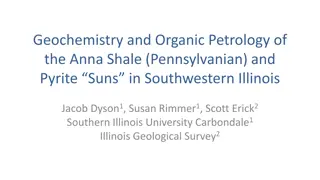Understanding Geochemistry and Its Impact on Human Health
This session, led by Dr. Patrick Asamoah Sakyi from the Department of Earth Science at UG, delves into the significance of geological elements in human health, discussing diseases arising from their deficiency or excess intake. Topics include geophagy, fluorine's impact on dental health, iodine deficiency disorders, arsenic toxicity, and more. Recommended readings are provided from Environmental Geology and Geohazards Institute resources.
Uploaded on Sep 16, 2024 | 0 Views
Download Presentation

Please find below an Image/Link to download the presentation.
The content on the website is provided AS IS for your information and personal use only. It may not be sold, licensed, or shared on other websites without obtaining consent from the author. Download presentation by click this link. If you encounter any issues during the download, it is possible that the publisher has removed the file from their server.
E N D
Presentation Transcript
Session 12 Geochemistry, Habits and Related Diseases Lecturer: Dr. Patrick Asamoah Sakyi Department of Earth Science, UG Contact Information: pasakyi@ug.edu.gh College of Education School of Continuing and Distance Education 2014/2015 2016/2017
Session Overview This session discusses the requirement of certain geological elements to enhance the normal growth or development of various organs and parts of the human body. It will also look at the diseases caused by the deficiency or excess intake of these elements and compound. For examples, moderate concentrations of some trace elements such as calcium, copper and molybdenum are required for good health because high concentrations are toxic and lower concentrations may also be harmful. Dr. Patrick A. Sakyi, Dept. of Earth Science Slide 2
Session Outline The key topics to be covered in the session are as follows: Topic One Eating of Clay and Associated Health Effects Topic Two - Fluorine and Dental Health Topic Three Iodine and Iodine Deficiency Disorders Topic Four Arsenic Topic Five - Aluminium Topic Six - Nitrate Topic Seven Selenium Topic Eight - Crystalline Silica Topic Nine - Molybdenum Topic Ten - Water hardness Slide 3 Dr. Patrick A. Sakyi, Dept. of Earth Science
Reading List Chapter 20 of Environmental Geology 4th Edition, Wm. C. Brown Publishers by Carla W Montgomery (1995) Unit 3, Sections 2 & 3 of UGRC 140 II Geohazards Institute of Continuing and Distance Education. Slide 4 Dr. Patrick A. Sakyi, Dept. of Earth Science
Topic One EATING OF CLAY AND ASSOCIATED HEALTH EFFECTS Slide 5 Dr. Patrick A. Sakyi, Dept. of Earth Science
Eating of Clay and Associated Health Effects Geophagy Geophagy is defined as the deliberate and regular consumption of earth-like materials such as soils, clays, chalk, and mineral substances by humans and animals. This is common in the tropics, and particularly in tropical Africa. It is especially common among pregnant women. Slide 6 Dr. Patrick A. Sakyi, Dept. of Earth Science
Eating of Clay and Associated Health Effects Geophagy By eating these earthy materials, the constituent trace elements will be consumed, and the increased concentrations of these elements will become toxic to the health of humans and animals. Slide 7 Dr. Patrick A. Sakyi, Dept. of Earth Science
Topic Two FLUORINE AND DENTAL HEALTH Slide 8 Dr. Patrick A. Sakyi, Dept. of Earth Science
Fluorine and Dental Health Fluorine (F) is an essential element in the human diet. Fluorine is added to drinking water to minimize the development of dental caries. Fluoride (F-) is important for the protection of teeth and bones. Lack of fluoride has long been linked to tooth decay - hence the effectiveness of fluoride toothpaste. The human teeth and bone is made up substantially of calcium. Slide 9 Dr. Patrick A. Sakyi, Dept. of Earth Science
Fluorine and Dental Health Low levels of fluorine provide protection for the teeth and prevent decay. However, excessive levels of fluorine in water forms a complex compound with the calcium. This then damages the enamel- forming cells. http://upload.wikimedia.org/wikipedia/commons/thumb/f/ff/MildFluorosis02-24-09.jpg/230px-MildFluorosis02-24-09.jpg The damage to these cells results in a mineralization disorder of the teeth, whereby the porosity of the enamel is increased and the mineral content decreased. Slide 10 Dr. Patrick A. Sakyi, Dept. of Earth Science
Fluorine and Dental Health This causes an irreversible condition known as Dental fluorosis (tooth decay). It occurs in different parts of Ghana. (e.g., Bongo in Upper East Region of Ghana) Slide 11 Dr. Patrick A. Sakyi, Dept. of Earth Science
Fluorine and Dental Health Similarly, overloads of fluorine/fluoride in the body affects the bones/skeleton and cause Skeletal Fluorosis. Slide 12 Dr. Patrick A. Sakyi, Dept. of Earth Science
Fluorine and Dental Health Occurrence of Fluoride in Groundwater When groundwater comes into contact with minerals like; topaz (Al2SiO4(F,OH)2), fluorite (CaF2), fluoroapatite (Ca5(PO4)3F), cryolite (Na3AlF6) Soluble fluoride ions from these minerals leach into the groundwater and contribute to high fluoride concentrations. Slide 13 Dr. Patrick A. Sakyi, Dept. of Earth Science
Fluorine and Dental Health Prevention of Fluorosis Fluorosis stains are permanent, and so, it is advisable to prevent the condition in the first place. Do not take fluoride supplements unless there are insufficient quantities of fluoride in your drinking water. Fluoride intake also includes fluoride from beverages, juices and soft drinks that contain fluoridated water, that can expose you to the risk of excessive fluoride consumption. Slide 14 Dr. Patrick A. Sakyi, Dept. of Earth Science
Fluorine and Dental Health Prevention of Fluorosis Children should; be given only small quantities of toothpaste on their toothbrush be taught the proper way to brush, including spitting out the toothpaste. not be given flavored toothpaste that may increase the chances of swallowing. Slide 15 Dr. Patrick A. Sakyi, Dept. of Earth Science
Topic Three IODINE AND IODINE DEFICIENCY DISORDERS Slide 16 Dr. Patrick A. Sakyi, Dept. of Earth Science
Iodine and Iodine Deficiency Disorders Iodine is essential to health and thus required to be present in the body at certain concentrations. Deficiency in dietary iodine can lead to a number of iodine-deficiency disorders (IDDs) such as goitre and irreversible brain damage in humans. Slide 17 Dr. Patrick A. Sakyi, Dept. of Earth Science
Iodine and Iodine Deficiency Disorders Occurrence of Iodine Most iodine in the terrestrial environment are normally derived through volatilization from the oceans. The principal sources of iodine in groundwater are aquifers, soils and the atmosphere. Higher concentrations can be found in saline waters. As a result of this major source of environmental iodine, soils in coastal regions are strongly enriched in iodine. Slide 18 Dr. Patrick A. Sakyi, Dept. of Earth Science
Iodine and Iodine Deficiency Disorders Occurrence of Iodine Most iodine in the terrestrial environment are normally derived through volatilization from the oceans. The principal sources of iodine in groundwater are aquifers, soils and the atmosphere. Higher concentrations can be found in saline waters. As a result of this major source of environmental iodine, soils in coastal regions are strongly enriched in iodine. Slide 19 Dr. Patrick A. Sakyi, Dept. of Earth Science
Iodine and Iodine Deficiency Disorders Occurrence of Iodine Mineral veins (rich in sulphide minerals) and hydrothermal solutions are also relatively concentrated in iodine. Sedimentary rocks such mudstone and shales have the highest concentrations of iodine. Weathered rocks often have higher iodine concentrations than their pristine equivalents, presumably due to interaction with groundwater. Slide 20 Dr. Patrick A. Sakyi, Dept. of Earth Science
Iodine and Iodine Deficiency Disorders Occurrence of Iodine Mineral veins (rich in sulphide minerals) and hydrothermal solutions are also relatively concentrated in iodine. Sedimentary rocks such mudstone and shales have the highest concentrations of iodine. Weathered rocks often have higher iodine concentrations than their pristine equivalents, presumably due to interaction with groundwater. Slide 21 Dr. Patrick A. Sakyi, Dept. of Earth Science
Topic Four ARSENIC Slide 22 Dr. Patrick A. Sakyi, Dept. of Earth Science
Arsenic Arsenic (As) is usually injested through inhalation. Chronic arsenic poisoning affects people mostly by direct exposure to arsenic contaminated water or arsenic polluted air. The possible sources of Arsenic include: Drinking water Dust Soil Food Slide 23 Dr. Patrick A. Sakyi, Dept. of Earth Science
Arsenic Patients affected exhibit typical symptoms including hyperpigmentation (darkening of an area of skin), hyperkeratosis (thickening of the skin), Bowen s disease (skin cancer of the outer skin layer). Slide 24 Dr. Patrick A. Sakyi, Dept. of Earth Science
Topic Five ALUMINIUM Slide 25 Dr. Patrick A. Sakyi, Dept. of Earth Science
Aluminium Aluminium is one of the most widely used metals. Sources of aluminium include soil, air, drinking water, food additives and health-care products (e.g. antacid). In the geological environment, aluminium is released during weathering of minerals such as feldspar (KAlSi3O8 ). Slide 26 Dr. Patrick A. Sakyi, Dept. of Earth Science
Aluminium Health Effects of Excess Intake of Aluminium Excess intake of Aluminium can cause; damage to the central nervous system, Alzheimer s disease/dementia/loss of memory listlessness severe trembling Shaver s Disease (Bauxite pneumoconiosis) Slide 27 Dr. Patrick A. Sakyi, Dept. of Earth Science
Topic Six NITRATE Slide 28 Dr. Patrick A. Sakyi, Dept. of Earth Science
Nitrate Naturally nitrate concentrations are very low in geological environments. Activities such as; agriculture (applications of fertilizers), industry, domestic effluents, and emissions from combustion engines usually results in the increase in the nitrates concentrations. Slide 29 Dr. Patrick A. Sakyi, Dept. of Earth Science
Nitrate Health Effects of excess Nitrates When nitrate concentrations reach excessive levels there can be harmful biological consequences for the organisms, especially in babies. Excessive intake of nitrate causes an infant disease known as methemoglobinemia, (or blue- baby syndrome) or Slide 30 Dr. Patrick A. Sakyi, Dept. of Earth Science
Nitrate Health Effects of excess Nitrates Blue-baby syndrome is an infant born with a congenital heart defect that prevents oxygen-rich blood from circulating to the body, which causes the infant s skin to have a bluish tint This syndrome is caused by high nitrate contamination in ground water resulting in decreased oxygen carrying capacity of hemoglobin in babies leading to death. or Slide 31 Dr. Patrick A. Sakyi, Dept. of Earth Science
Topic Seven SELENIUM Slide 32 Dr. Patrick A. Sakyi, Dept. of Earth Science
Selenium Selenium (Se) is essential to human and animal health in small amounts. Selenium occurs in the food chain through the soil and into plants. It is also released to the environment from its use in the ceramics, photocopiers and pharmaceutical industries. or Slide 33 Dr. Patrick A. Sakyi, Dept. of Earth Science
Selenium Health Implications Selenium deficiency has been implicated in; white muscle disease in animals, and cancer in humans, a potentially fatal heart disease called Keshan disease. it also includes Kashin-Beck disease, a bone and joint disorder. or Slide 34 Dr. Patrick A. Sakyi, Dept. of Earth Science
Selenium Health Implications In contrast, excess selenium causes selenosis, which results in; intestinal distress resulting in vomiting; diarrhea malformation of hair (balding) and nail loss, mental malfunctioning nervousness in humans. Slide 35 Dr. Patrick A. Sakyi, Dept. of Earth Science
Selenium Possible Treatments for Keshan Diseases The treatment for Keshan disease is selenium supplementation, supplementary Vitamin E or both. Intake of diet that includes seafood, meats such as kidney, and liver, and some grains and seeds; all of these are high in selenium. Garlic, onions, mushroom, broccoli, tomatoes, and radishes, may be good sources of selenium if the soil in which they are grown contains it. Slide 36 Dr. Patrick A. Sakyi, Dept. of Earth Science
Selenium Possible Treatments for Keshan Diseases Selenium supplements may improve the levels of selenium in the body. The supplements cannot reverse any of the heart muscle damage that has already occurred. Slide 37 Dr. Patrick A. Sakyi, Dept. of Earth Science
Topic Eight CRYSTALLINE SILICA Slide 38 Dr. Patrick A. Sakyi, Dept. of Earth Science
Crystalline Silica Anything quartz, granite, sandstone, sand or clay contains a form of silica. For instance, bricks, ceramics, roads, concrete, sandpaper, filters for municipal water supplies, desiccants, toothpaste, paper and materials for industry contain silica. Slide 39 Dr. Patrick A. Sakyi, Dept. of Earth Science
Crystalline Silica Silica and Silicosis Silicosis is a lung disease caused by silica (SiO2). Silica can become airborne during windy conditions or during construction activities as well as during volcanic eruptions. These are inhaled through the nostrils into the lungs. Slide 40 Dr. Patrick A. Sakyi, Dept. of Earth Science
Crystalline Silica Silica and Silicosis In the lungs the small crystalline silica particles are taken up by microphages that die and accumulate near blood vessels. The connective tissues form around these masses, producing fibrous nodules in the lungs resulting in major respiratory problems and death. Slide 41 Dr. Patrick A. Sakyi, Dept. of Earth Science
Topic Nine MOLYBDENUM Slide 42 Dr. Patrick A. Sakyi, Dept. of Earth Science
Molybdenum Elevated levels of molybdenum in soils causes health problems for grazing livestock. Ingestion of excessive levels of molybdenum leads to Molybdenosis. High concentrations of molybdenum inhibits the absorption of Cu resulting in Cu deficiency. This may lead to stunted growth and unhatched eggs in poultry. Slide 43 Dr. Patrick A. Sakyi, Dept. of Earth Science
Topic Ten WATER HARDNESS Slide 44 Dr. Patrick A. Sakyi, Dept. of Earth Science
Water Hardness Water hardness mainly refers to water which is unable to produce lather with soap. As water moves through rocks and soils, soluble minerals are dissolved and these are transported in solution. The dissolution of calcium (Ca2+) and magnesium (Mg2+) in water causes the water to be "hard." E.g. calcite (CaCO3), anhydrite (CaSO4) and dolomite (CaMg(CO3)2). The degree of hardness is dependent on the concentration of calcium and magnesium in the water. Slide 45 Dr. Patrick A. Sakyi, Dept. of Earth Science
Water Hardness Clothes laundered in hard water may look dingy and feel harsh and scratchy. Dishes and glasses may be spotted when dry. Hair washed in hard water may feel sticky and look dull. Slide 46 Dr. Patrick A. Sakyi, Dept. of Earth Science
Summary Both natural and human-induced activities can result in increased levels of trace elements. The intake of trace elements into the body may have serious health implications for us, depending on whether it is in excess or deficient. Most of the diseases are mental malfunctioning, heart- related diseases, dental and skeletal fluorosis, goitre, blue-baby syndrome, etc. Slide 47 Dr. Patrick A. Sakyi, Dept. of Earth Science
END Slide 48 Dr. Patrick A. Sakyi, Dept. of Earth Science




